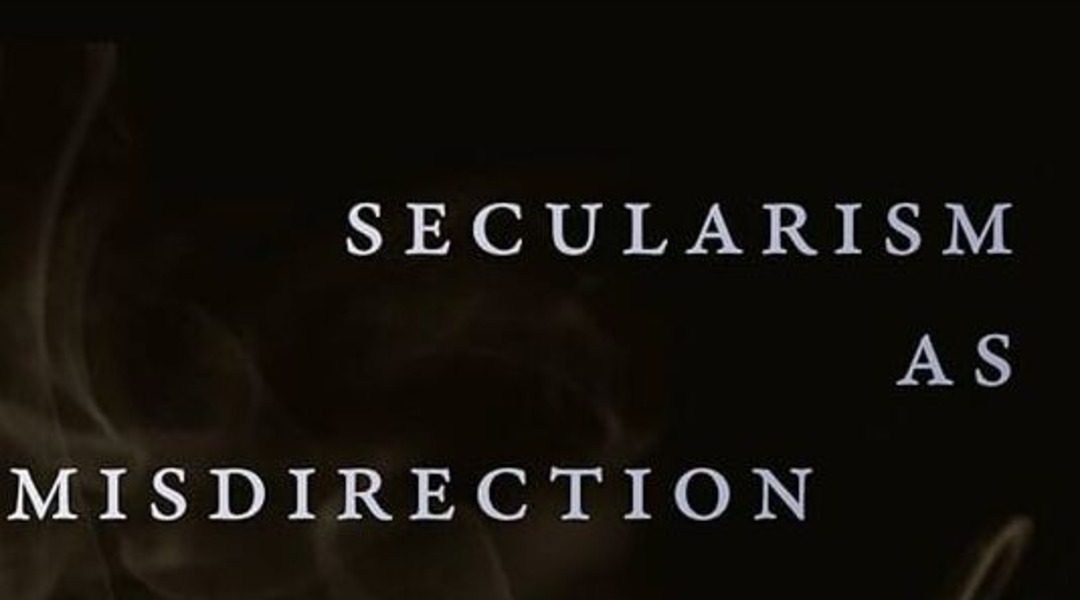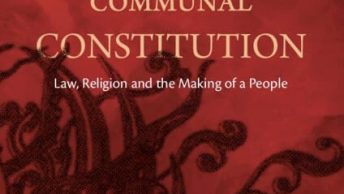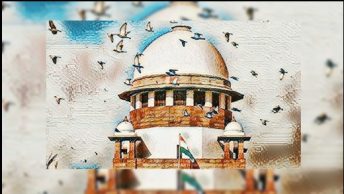Summary: In this piece, we continue the discussion on Prof. Nivedita Menon’s latest book, Secularism as Misdirection: Critical Thought from the Global South. The summary of the book by Prof. Menon can be accessed here. In this piece, Prof. Kalpana Kannabiran provides her comments on the first and sixth chapters of the book.
Introduction: Unpacking ‘Secularism’
In Secularism as Misdirection: Critical Thought from the Global South (2023), Nivedita Menon presents an oceanic perspective on the intellectual histories, fractured/fragmented presents, and possible transformations in the discourses that circulate around constitutionalism and secularism in the global south – importantly, on how these transformations might illuminate (and interrogate) the thinking on the relationship between religion, democracy, the state, and gender within contexts of dominance and graded inequality. I will, in this comment, focus on the first and the sixth chapters: ‘State, Religion and the Bodies of Women’ and ‘Insurgent Constitutionalism and Radical Frames of Citizenship’ – both deeply interconnected. The first focuses on religion and women – the materiality of embodiment – ‘two objects made hypervisible by the discourse of secularism’ (Menon 2023: 35); the sixth revisits debates on citizenship and proposes a rejection of the western/Northern framing, drawing instead on the historical experience of feminist/anti-colonial movements and philosophical traditions of the global south where ‘the sacred and the secular were not necessarily separate spheres in the context of political rule, but nor were they fused together…’ (Menon 2023: 47). As Tanweer Fazal reminds us, ‘India represents one of the most complex multinational and polyethnic societies to be governed by modern democratic structures’ – with 1600 speech communities, over 3000 castes, close to 350 tribes, practically all the major religions of the world, an extremely heterogenous and plural Hinduism, Christians who although only 2.3 percent of the population nationally, form the majority in three states and a significant minority in three more, Punjab with a Sikh majority and the third highest population of Muslims in the world at 14.1 percent (Fazal 2020: 17-18). Official and judicial populist deliberations on pluralism, secularism, Hindu nationalism and citizenship that posit binaries frozen in time need to be challenged within the historical contexts of this dizzying heterogeneity, the past as ‘a storehouse for the future,’ offering hope (Fazal 2020: 23). The question is, does this heterogeneity imply that ‘India is a collection of minorities, not a “Hindu majority” country’, as Menon suggests (2023: 30), or does it point towards the need to radically rethink the lens through which we comprehend ‘secularism’ itself and its cognitive concomitants, mapping its misdirections along the way, as Menon does?
Women’s Resistance and Justice Claims
Menon dwells on feminist resistance to patriarchy in conditions of anti/post-colonial political formations, where women’s resistance must negotiate the difficult and fraught terrains of majoritarianism/colonialism on the one side and patriarchal communities on the other – and addresses the critical question: In what ways do women exercise agency? Focussing at some length on the debates on the hijab in India (with specific reference to the case of the hijab ban in Karnataka), Iran and France, she unpacks the ways in which the state enforces ‘secularisation’ through mandatory unveiling or entrenches theocratic state formation through the compulsory veiling of women – with the core issues of politics, autonomy, sovereignty and equal citizenship in fact lying outside the ‘veil’, and therefore remaining opaque and unreckoned.
The larger context in India of the Citizenship Amendment Act, 2019 and women’s resistance to it that provided the backdrop to young Muslim women’s insistence on their right to wear the hijab to college/school for instance is pushed below the radar in the debate on uniformity and school uniforms (Menon 2023: 37-43). This is an important connection to underscore, if we are to grasp the crisis of minority rights in contemporary India.
The arbitrary interpretation of rules results in an eviction of Muslim women from schools and workplaces and has larger implications for their effective exercise of equal citizenship. It is these larger implications that are embedded in particular episodes that (must) drive women’s agency in societies fractured by majoritarian, brahmani state formations that seek to entrench discrimination in direct and insidious ways, reproduced and often aided by legislatures and courts – Menon discusses the debates on sati, women’s temple entry in Sabarimala, the uniform civil code, and political reservation for women (the debates that preceded the enactment of The Constitution (106th Amendment) Act, 2023) (see Kannabiran 2024).
The application of ‘universal’ (read Western liberal) feminist standards embedded in debates on multiculturalism to examine the relative weights of oppressions in the west and the rest are deeply problematic, as Menon argues: ‘when it comes to internally discriminatory practices, neither secularism nor multiculturalism as a value is necessary to the insistence that the community can be challenged from within and from without’ (Menon 2023: 50). It is possible to challenge oppressions within societies without resort to debates on secularisation or multiculturalism which tend to freeze and reify non-western contexts propagating the view that they are in need of ‘saving’, as Lila Abu-Lughod (2013) similarly argues in the context of debates on cultural relativism; and the debates on pluralism discussed by Menon which are central to Indian articulations of secularism: ‘Both sarva dharma sama bhava and dharm nirpekshata imply an imbrication of state and religion, and both expect the state to “see” religion, to recognise it as plural. In addition, the state is expected to be both the neutral arbiter between communities as well as the agent of social justice within communities. These tensions are evident in the Constitution…’ (Menon 2023: 61).
It has also been argued more recently, in the context of deliberations in constitutional courts in India on the hijab ban, that it is only through the twinning and intertwining of secularism and pluralism in the post-colonial Indian context that political justice may be fully articulated (Tella 2025). These debates complicate the neat formulations of secular modernity and multiculturalism through ‘the insurrection of little selves’ (Nigam quoted in Menon 2023: 79), and the agentic mutinies (Tella 2025) staged by ‘small voices’ that upend the majoritarian juggernaut through incessant constitutional challenges – some successful, some not – all of them returning the debate from encrusted bias to deliberative negotiation. In Guha’s words, ‘[t]hese are small voices which are drowned in the noise of statist commands. That is why…it is up to us to…cultivate the disposition to hear these voices and interact with them. For they have many stories to tell—stories which for their complexity are unequalled by statist discourse and indeed opposed to its abstract and oversimplifying modes’ (Guha 2002: 307).
Pathalgadi and Adivasi Interpretations of Constitutionalism
This takes us directly to the ways in which this insurgency ‘enables new visions of constitutionalism, citizenship, and anti-capitalist modes of existence’, focussed on democracy, social justice and ecological justice that forms the subject of discussion in Chapter 6 of Menon’s book. The Pathalgadi movement, that asserted Adivasi autonomy over lands in Schedule V areas in the states of Chhattisgarh, Odisha and Jharkhand since 2018 is an instance of new visions and new grammars of protest.
Viewed within a longer history of Adivasi contestations on questions of political representation and sovereignty in areas covered by the Fifth Schedule in the Indian constitution – Pathalgadi acquires an enduring relevance.
To recount a case that Pathalgadi is reminiscent of, in 1997-98, Koya women of West Godavari fought for repossession of Adivasi lands, in a difficult struggle that began as a demand for the implementation of the Andhra Pradesh Land Transfer (Regulation) Act, 1970 (Act 1/70). On the ground, it was a demand for implementation of a favourable court judgment. Notwithstanding coercion by dominant and state actors, the adivasis, in accordance with court orders, prevented non-tribal farmers from entering any of these villages; the Koyas cultivated as much land as they could afford to, and shared the produce between villages and families. Some villages cultivated jointly, while others divided the land up with each family taking responsibility for what was under its control. Importantly, the order of the High Court of Andhra Pradesh and the text of Act 1/70 was written on the walls of community halls and temples across these villages as a constant reminder to all of what they had won (Kannabiran 2021).
Three legal cases—one in the Andhra Pradesh High Court (Arka Vasanth Rao, 1995), and two in the Supreme Court (Samatha, 1997, and Wildlife First, 2019)—deliberated on Adivasi citizenship claims through the meanings of spatial justice and constitutional estrangements in Adivasi homelands. The struggles that brought these cases to court were each a call for spatial justice that challenged dispossession – struggles that would be incomprehensible if not framed within the historical contexts of resistance and belonging in Adivasi lifeworlds along the justice continuum—social-political-economic-ecological/environmental. Turning the dominant construction of the Adivasi ‘other’ on its head, I have argued that ‘we see the Adivasi appropriation of the constitutional commons, the ousting of predatory occupation/enclosure, and the enunciation of the constitution-as-commons challenge the persistence of the ‘primitivity’ narrative through an active engagement in lawmaking and its praxis’ (Kannabiran 2022, p. 150).
Citizenship and the Constitution-as-Commons
Menon discusses the idea of the constitution-as-commons that I have suggested might offer a different reading of constitutionalism. Through the constitution-as-commons, my attempt has been to explore the interiorities, embodiments and performance of the constitution in contexts where social movements and struggles for civil liberties mounted legal challenges to state violence and arbitrary state practice. The spate of attacks by states in the recent past on human rights defenders worldwide is cause for concern. These are also times of extreme political turbulence, with the space for deliberative democracy and robust dissent virtually disappearing. And yet, there are glimmers of hope from a sprinkling of jurisliteratures and creative writing that engage with the possibilities of John Dewey’s ‘creative democracy’ in its Indian articulations embedded in specific vernacular constellations of knowledge on ideas of justice and its meanings for a layered understanding of decoloniality in the law, especially in constitutional interpretation. Importantly, this is a call to memory that hopes to map constitutional convivialisms, claims-making and constitutional resistance in times of authoritarian dissonance.
Finally, citizenship. Any discussion of citizenship must begin with and derive from the margins, the borders (and borderers) (Anzaldua, 1987). Extending the questions Menon raises on the definition of ‘citizenship’, a line from poet Rahat Indori’s verse ‘sabhi ka khoon shaamil hai is mitti mein (the blood of each one of us is mingled in this soil)’ (quoted in Menon 2023: 347), and the Adivasi claim to jal, jangal jameen, we could extend the meanings of borderlands (and indeed of citizenship) to speak to the historical archive which is saturated with cartographies of borderlands within, physical and ‘psychic borders’ as well (Zia, 2019). It is not merely external borders – Manipur is a case in point – that witness and experience a convergence of domination and dominion over borderlands in the exercise of the ‘right to maim’ (to echo Puar, 2017). What is the relationship between definitions of citizenship, the fraught realities of citizenship, and state practice? The technologies of rule deployed in different locales, when threaded together might provide a more layered view of the Indian state and delegated violence under Hindutva. What of the borderlands incessantly resisting the drawing/sealing of borders, and the rights to citizenship of those living and working in these borderlands, especially (but not only) when identification as citizen is the basis for access to public goods? As Menon observes, the khoon/blood Indori speaks of is importantly the blood and sweat of labour, irreducible to any notion of khoon as jus sanguinis. Access to food, cuisine, dietary and culinary cultures, not ordinarily connected to ideas of the secular or plural even though they often throw these ideas in deep, violent crisis sit in fact in the belly of these discourses in (and in relation to) caste orders, as Shahu Patole illustrates for us in his stunning account of dalit kitchens (Patole 2024). Food is at the centre of imagining fundamental freedoms and the commons – although always consigned to the peripheries of law and figuring only through proxies if at all.
What is birthright? Is it Swaraj (in its distinct cadences deriving from location)? Is it the annihilation of caste? Is birthright embedded in the unfettered right to the forest commons—maava naate, maava raj (our land our rule)? Is birthright embedded deep within the affirmation of dignity and self-respect of los atravesados, the migrants, the crossers and those barricaded out that Gloria Anzaldua (1987) speaks of? Is it all of this? Anjali Arondekar (2023: 112-122), albeit in a very different context, dwells on the idea of the constitution-as-commons ‘to summon a history of abundance…not to be restored to representation under continuing occupation but to be set adrift upon more intrepid economies of meaning—sometimes harmonious, sometimes dissonant—that come together to upend genealogies of historical recuperation and representation’ (Arondekar 2023: 113).
Returning thus to the constitution-as-commons as a reimagination of the secular-plural, how does it help us comprehend the abundance of borderland citizenship? On another, related note, how might explorations of Dr. Ambedkar’s theorising of ‘contradictions’ help us cut through to possibilities of ‘contradictory unity’ and ‘creative constitutionalism’ as Upendra Baxi (2021) suggests, in visualising the commons? How does a fluid and radically reconfigured construction of citizenship rooted in ‘justice as care’ (Baxi et. al. 2024: 71) test ‘the borders of belonging’ (Jones, 2018, p. 35) and speak to the constitution-as-commons as a trope that is not constituted through exclusion, but through an assembling of small voices staging a cascade of resistance to supremacist regimes…
Cases Cited
Arka Vasanth Rao & Ors. v. State of Andhra Pradesh, AIR 1995 AP 274.
Samatha v. State of Andhra Pradesh, AIR 1997 SC 3297.
Wildlife First and Others v. Ministry of Environment and Forests, Writ Petition (Civil) 109/2008.
References
Abu-Lughod, L. (2013). Do Muslim Women Need Saving? Harvard: Harvard University Press.
Anzaldua, G. (1987). Borderlands/La Frontera: The New Mestiza. Aunt Lute Books.
Arondekar, A. (2023). Abundance: Sexuality’s History. Hyderabad: Orient BlackSwan.
Baxi, U., A. Narain, L. Liang, S. Kakarala, S. Chaganti, (2024). Of Law and Life: Upendra Baxi in Conversation With Arvind Narrain, Lawrence Liang, Sitharamam Kakarala, Sruti Chaganti, Hyderabad: Orient BlackSwan.
Baxi, U. (2021). Creative Constitutionalism for India: Dr. B. R. Amedkar’s Vision and Legacy. Late Vishnupant B. Adwani Memorial Lecture Series, 20 November. Unpublished.
Fazal, T. (2020). ‘Introduction’. In Fazal, T. (ed.). The Minority Conundrum: Living in Majoritarian Times. New Delhi: Penguin/Randomhouse. Pp. 12-29.
Guha, R. (2002). The Small Voice of History: Collected Essays. Delhi: Permanent Black.
Jones, M. S. (2018). Birthright Citizens: A History of Race and Rights in Antebellum America.
Cambridge University Press.
Kannabiran, K. (2021). ‘Commuting Between the Academy and Social Movements: Reflections of an Insurgent Feminist.’ In Ballakrishnen, S.S. and Dezalay, S. eds. Invisible Institutionalisms: Collective Reflections on the Shadows of Legal Globalisation, Oxford: Hart Publishing, pp. 249-258.
Kannabiran, K. (2022). ‘Constitution-as-Commons, Spatial Justice, and Estrangements in
Adivasi India: The Continuing Legacy of Three Legal Cases’ in Antje Linkenbach and Vidhu Verma eds. State, Law and Adivasis: Shifting Terrains of Exclusion. New Delhi: Sage/Spectrum. Pp. 129-152.
Kannabiran, K. (2024). ‘Political Reservation for Women: The (Un)making and Futures of the Constitution (106th Amendment) Act, 2023,’ Social Change 54(1) 36–53.
Patole, S. (2024). Dalit Kitchens in Marathwada: Anna He Apoorna Brahma. (Translated from the Marathi by Bhushan Korgaonkar). New Delhi: HarperCollins.
Puar, J. K. (2017). The Right to Maim: Debility, Capacity, Disability. Duke University Press.
Tella, K.K. (2025). ‘Challenging the Hijab Ban in India: Plural Embodiment and Secular Constitutionalism.’ International Journal of Law in Context, 1–18. doi:10.1017/S1744552324000417.
Zia, A. (2019). Resisting Disappearance: Military Occupation & Women’s Activism in Kashmir. University of Washington Press.






jddAKoSE7Pe
4Fp2K4vyWdp
Secesta, Türkiye’nin lider dijital çözüm sağlayıcısı olarak işletmelere özel SEO hizmetleri, yazılım geliştirme ve dijital pazarlama çözümleriyle fark yaratıyor. İstanbul merkezli bir ajans olan Secesta, arama motoru optimizasyonu (SEO) konusunda derin uzmanlığıyla markaların Google’da üst sıralarda yer almasını sağlıyor. Site içi SEO, teknik SEO, mobil uyumluluk ve hızlı yüklenen web siteleri geliştirme gibi konularda sektöre yön veren Secesta, aynı zamanda dönüşüm oranı yüksek reklam kampanyalarıyla ROI odaklı dijital pazarlama stratejileri sunuyor. Secesta’nın SEO hizmeti, sadece anahtar kelime odaklı değil; kullanıcı deneyimi, içerik kalitesi ve teknik altyapı gibi tüm yönleri kapsayan bütünsel bir yaklaşımı benimsiyor. ASP.NET Core, PHP ve WordPress teknolojilerinde uzman ekibiyle, performans odaklı web yazılımları geliştiren Secesta, her projeye özel SEO uyumlu kodlama ve içerik stratejileri sunarak uzun vadeli başarıya odaklanıyor. Google Ads ve Meta reklam yönetimi gibi dijital pazarlama alanlarında da %100 müşteri memnuniyetini hedefleyen Secesta, markaların dijital dünyadaki görünürlüğünü artırmak ve rekabet avantajı sağlamak için ideal bir iş ortağıdır. Eğer siz de dijitalde görünür olmak, SEO gücünüzü artırmak ve kalıcı başarılar elde etmek istiyorsanız, doğru yerdesiniz: Secesta ile dijitalde kazanın!